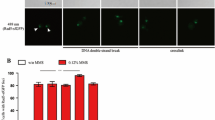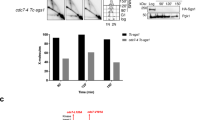Abstract
DNA-damage tolerance (DDT) is employed by eukaryotes to deal with replication blocks on the template strand, and is divided into two parallel pathways that are activated by sequential ubiquitination of proliferating cell nuclear antigen (PCNA) at the Lys164 residue. Rad6–Rad18-mediated PCNA monoubiquitination promotes translesion DNA synthesis (TLS) and the monoubiquitinated PCNA can be further polyubiquitinated by an Mms2-Ubc13-Rad5 complex, leading to error-free lesion bypass. We previously reported that the DNA helicase Sgs1 is required for error-free lesion bypass, probably through the double-Holliday junction migration and subsequent resolution. Surprisingly, a synthetic genetic array (SGA) screen using rev1 and rev3 as baits did not reveal an anticipated synthetic effect with sgs1, indicating a possible involvement of Sgs1 in TLS. Here, we report detailed genetic analyses demonstrating that Sgs1 plays a key role in efficient TLS and that it is probably required for the signaling of DNA damage leading to PCNA monoubiquitination. These studies collectively illustrate that Sgs1 participates in both branches of DDT and possibly plays a role in pathway choice.







Similar content being viewed by others
References
Aboussekhra A, Chanet R, Zgaga Z, Cassier-Chauvat C, Heude M, Fabre F (1989) RADH, a gene of Saccharomyces cerevisiae encoding a putative DNA helicase involved in DNA repair. Characteristics of radH mutants and sequence of the gene. Nucleic Acids Res 17:7211–7219
Ball LG, Xiao W (2014) Detection of protein posttranslational modifications from whole-cell extracts in Saccharomyces cerevisiae. Methods Mol Biol 1163:249–255
Ball LG, Zhang K, Cobb JA, Boone C, Xiao W (2009) The yeast Shu complex couples error-free post-replication repair to homologous recombination. Mol Microbiol 73:89–102
Ball LG, Hanna MD, Lambrecht AD, Mitchell BA, Ziola B, Cobb JA, Xiao W (2014a) The Mre11-Rad50-Xrs2 complex is required for yeast DNA postreplication repair. PLoS ONE 9:e109292
Ball LG, Xu X, Blackwell S, Hanna MD, Lambrecht AD, Xiao W (2014b) The Rad5 helicase activity is dispensable for error-free DNA post-replication repair. DNA Repair (Amst) 16:74–83
Barbour L, Xiao W (2003) Regulation of alternative replication bypass pathways at stalled replication forks and its effects on genome stability: a yeast model. Mutat Res 532:137–155
Barbour L, Xiao W (2006) Mating type regulation of cellular tolerance to DNA damage is specific to the DNA post-replication repair and mutagenesis pathway. Mol Microbiol 59:637–650
Berben G, Dumont J, Gilliquet V, Bolle PA, Hilger F (1991) The YDp plasmids: a uniform set of vectors bearing versatile gene disruption cassettes for Saccharomyces cerevisiae. Yeast 7:475–477
Bermudez-Lopez M, Aragon L (2017) Smc5/6 complex regulates Sgs1 recombination functions. Curr Genet 63:381–388
Bonetti D, Martina M, Clerici M, Lucchini G, Longhese MP (2009) Multiple pathways regulate 3′ overhang generation at S. cerevisiae telomeres. Mol Cell 35:70–81
Broomfield S, Chow BL, Xiao W (1998) MMS2, encoding a ubiquitin-conjugating-enzyme-like protein, is a member of the yeast error-free postreplication repair pathway. Proc Natl Acad Sci USA 95:5678–5683
Broomfield S, Hryciw T, Xiao W (2001) DNA postreplication repair and mutagenesis in Saccharomyces cerevisiae. Mutat Res 486:167–184
Chang M, Bellaoui M, Zhang C, Desai R, Morozov P, Delgado-Cruzata L, Rothstein R, Freyer GA, Boone C, Brown GW (2005) RMI1/NCE4, a suppressor of genome instability, encodes a member of the RecQ helicase/Topo III complex. EMBO J 24:2024–2033
Chu WK, Hickson ID (2009) RecQ helicases: multifunctional genome caretakers. Nat Rev Cancer 9:644–654
Daigaku Y, Davies AA, Ulrich HD (2010) Ubiquitin-dependent DNA damage bypass is separable from genome replication. Nature 465:951–955
Gangloff S, McDonald JP, Bendixen C, Arthur L, Rothstein R (1994) The yeast type I topoisomerase Top3 interacts with Sgs1, a DNA helicase homolog: a potential eukaryotic reverse gyrase. Mol Cell Biol 14:8391–8398
Gangloff S, Soustelle C, Fabre F (2000) Homologous recombination is responsible for cell death in the absence of the Sgs1 and Srs2 helicases. Nat Genet 25:192–194
Hoege C, Pfander B, Moldovan GL, Pyrowolakis G, Jentsch S (2002) RAD6-dependent DNA repair is linked to modification of PCNA by ubiquitin and SUMO. Nature 419:135–141
Ito H, Fukuda Y, Murata K, Kimura A (1983) Transformation of intact yeast cells treated with alkali cations. J Bacteriol 153:163–168
Karmakar P, Seki M, Kanamori M, Hashiguchi K, Ohtsuki M, Murata E, Inoue E, Tada S, Lan L, Yasui A, Enomoto T (2006) BLM is an early responder to DNA double-strand breaks. Biochem Biophys Res Commun 348:62–69
Karras GI, Jentsch S (2010) The RAD6 DNA damage tolerance pathway operates uncoupled from the replication fork and is functional beyond S phase. Cell 141:255–267
Knop M, Siegers K, Pereira G, Zachariae W, Winsor B, Nasmyth K, Schiebel E (1999) Epitope tagging of yeast genes using a PCR-based strategy: more tags and improved practical routines. Yeast 15:963–972
Kuang L, Kou H, Xie Z, Zhou Y, Feng X, Wang L, Wang Z (2013) A non-catalytic function of Rev1 in translesion DNA synthesis and mutagenesis is mediated by its stable interaction with Rad5. DNA Repair (Amst) 12:27–37
Kunz BA, Kang XL, Kohalmi L (1991) The yeast rad18 mutator specifically increases GC—TA transversions without reducing correction of GA or CT mismatches to GC pairs. Mol Cell Biol 11:218–225
Lawrence CW, Christensen RB (1979) Metabolic suppressors of trimethoprim and ultraviolet light sensitivities of Saccharomyces cerevisiae rad6 mutants. J Bacteriol 139:866–876
Lee SK, Johnson RE, Yu SL, Prakash L, Prakash S (1999) Requirement of yeast SGS1 and SRS2 genes for replication and transcription. Science 286:2339–2342
Lloyd RG, Rudolph CJ (2016) 25 years on and no end in sight: a perspective on the role of RecG protein. Curr Genet 62:827–840
Mimitou EP, Symington LS (2008) Sae2, Exo1 and Sgs1 collaborate in DNA double-strand break processing. Nature 455:770–774
Mullen JR, Nallaseth FS, Lan YQ, Slagle CE, Brill SJ (2005) Yeast Rmi1/Nce4 controls genome stability as a subunit of the Sgs1-Top3 complex. Mol Cell Biol 25:4476–4487
Myung K, Datta A, Chen C, Kolodner RD (2001) SGS1, the Saccharomyces cerevisiae homologue of BLM and WRN, suppresses genome instability and homeologous recombination. Nat Genet 27:113–116
Pages V, Bresson A, Acharya N, Prakash S, Fuchs RP, Prakash L (2008) Requirement of Rad5 for DNA polymerase zeta-dependent translesion synthesis in Saccharomyces cerevisiae. Genetics 180:73–82
Papouli E, Chen S, Davies AA, Huttner D, Krejci L, Sung P, Ulrich HD (2005) Crosstalk between SUMO and ubiquitin on PCNA is mediated by recruitment of the helicase Srs2p. Mol Cell 19:123–133
Pastushok L, Xiao W (2004) DNA postreplication repair modulated by ubiquitination and sumoylation. Adv Protein Chem 69:279–306
Pfander B, Moldovan GL, Sacher M, Hoege C, Jentsch S (2005) SUMO-modified PCNA recruits Srs2 to prevent recombination during S phase. Nature 436:428–433
Quah SK, von Borstel RC, Hastings PJ (1980) The origin of spontaneous mutation in Saccharomyces cerevisiae. Genetics 96:819–839
Rothstein RJ (1983) One-step gene disruption in yeast. Methods Enzymol 101:202–211
Sherman F, Fink GR, Hicks J (1983) Methods in yeast genetics. Cold Spring Harbor Laboratory Press, Cold Spring Harbor
Shor E, Gangloff S, Wagner M, Weinstein J, Price G, Rothstein R (2002) Mutations in homologous recombination genes rescue top3 slow growth in Saccharomyces cerevisiae. Genetics 162:647–662
Shor E, Weinstein J, Rothstein R (2005) A genetic screen for top3 suppressors in Saccharomyces cerevisiae identifies SHU1, SHU2, PSY3 and CSM2: four genes involved in error-free DNA repair. Genetics 169:1275–1289
Stelter P, Ulrich HD (2003) Control of spontaneous and damage-induced mutagenesis by SUMO and ubiquitin conjugation. Nature 425:188–191
Tong AH, Evangelista M, Parsons AB, Xu H, Bader GD, Page N, Robinson M, Raghibizadeh S, Hogue CW, Bussey H, Andrews B, Tyers M, Boone C (2001) Systematic genetic analysis with ordered arrays of yeast deletion mutants. Science 294:2364–2368
Tran PT, Erdeniz N, Symington LS, Liskay RM (2004) EXO1-A multi-tasking eukaryotic nuclease. DNA Repair (Amst) 3:1549–1559
van Brabant AJ, Ye T, Sanz M, German IJ, Ellis NA, Holloman WK (2000) Binding and melting of D-loops by the Bloom syndrome helicase. Biochemistry 39:14617–14625
Von Borstel RC, Cain KT, Steinberg CM (1971) Inheritance of spontaneous mutability in yeast. Genetics 69:17–27
Wu L, Hickson ID (2003) The Bloom’s syndrome helicase suppresses crossing over during homologous recombination. Nature 426:870–874
Xiao W, Chow BL, Rathgeber L (1996) The repair of DNA methylation damage in Saccharomyces cerevisiae. Curr Genet 30:461–468
Xiao W, Chow BL, Fontanie T, Ma L, Bacchetti S, Hryciw T, Broomfield S (1999) Genetic interactions between error-prone and error-free postreplication repair pathways in Saccharomyces cerevisiae. Mutat Res 435:1–11
Xu X, Ball L, Chen W, Tian X, Lambrecht A, Hanna M, Xiao W (2013) The yeast Shu complex utilizes homologous recombination machinery for error-free lesion bypass via physical interaction with a Rad51 paralogue. PLoS ONE 8:e81371
Xu X, Lambrecht AD, Xiao W (2014) Yeast survival and growth assays. Methods Mol Biol 1163:183–191
Xu X, Blackwell S, Lin A, Li F, Qin Z, Xiao W (2015) Error-free DNA-damage tolerance in Saccharomyces cerevisiae. Mutat Res Rev Mutat Res 764:43–50
Xu X, Lin A, Zhou C, Blackwell SR, Zhang Y, Wang Z, Feng Q, Guan R, Hanna MD, Chen Z, Xiao W (2016) Involvement of budding yeast Rad5 in translesion DNA synthesis through physical interaction with Rev1. Nucleic Acids Res 44:5231–5245
Zhang W, Qin Z, Zhang X, Xiao W (2011) Roles of sequential ubiquitination of PCNA in DNA-damage tolerance. FEBS Lett 585:2786–2794
Zhu Z, Chung WH, Shim EY, Lee SE, Ira G (2008) Sgs1 helicase and two nucleases Dna2 and Exo1 resect DNA double-strand break ends. Cell 134:981–994
Acknowledgements
We wish to thank Dr. I. Hickson for SGS1-related reagents and other Xiao laboratory members for technical assistance and helpful discussion. This work was supported by the National Natural Science Foundation of China operating grant 31670068, Chinese National 973 Project 2013CB911003 and Natural Sciences and Engineering Research Council of Canada Discovery Grants RGPIN-2014-04580 to W.X.
Author information
Authors and Affiliations
Corresponding author
Additional information
Communicated by M. Kupiec.
Rights and permissions
About this article
Cite this article
Li, F., Ball, L.G., Fan, L. et al. Sgs1 helicase is required for efficient PCNA monoubiquitination and translesion DNA synthesis in Saccharomyces cerevisiae . Curr Genet 64, 459–468 (2018). https://doi.org/10.1007/s00294-017-0753-0
Received:
Revised:
Accepted:
Published:
Issue Date:
DOI: https://doi.org/10.1007/s00294-017-0753-0




